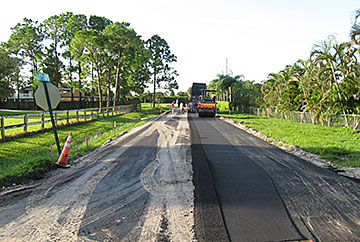Road Construction
 The District, nor the Board of Supervisors, initiates roadway improvements as South Indian River Water Control District has only limited powers under Chapter 298 of the Florida Statutes. Under Special District regulations, improvement projects, such as roadway upgrades, are limited to those initiated by the landowners. The following information provides general guidance only. For further information, please contact the Executive Director at the District office or the District Engineer.
The District, nor the Board of Supervisors, initiates roadway improvements as South Indian River Water Control District has only limited powers under Chapter 298 of the Florida Statutes. Under Special District regulations, improvement projects, such as roadway upgrades, are limited to those initiated by the landowners. The following information provides general guidance only. For further information, please contact the Executive Director at the District office or the District Engineer.
There are currently two approved District standards for roads within the District:
Unsurfaced Roadways - Most of the roads within the District are considered "dirt" or unsurfaced roads. These roads contain, for the most part, roadway base material such as shellrock or limerock to stabilize the road and are maintained by grading and adding aggregate material when necessary.
Asphalt - A high-quality road that is designed and constructed to support heavy traffic loads and/or high traffic volumes and utilize materials such as asphaltic concrete (flexible). These roads are designed to a Palm Beach County pavement section for local roadways.
The District will investigate other alternative road surfacing materials that can provide an improved surface at an affordable cost if and when they become available, but currently, only asphalt is approved by the Board. Landowners may also choose to utilize a road paving program provided by Palm Beach County.
A roadway improvement by South Indian River Water Control District can only occur if the roadway is under easement or ownership by the District or is under a maintenance agreement with the District. A roadway that does not demonstrate these previously stated qualities cannot be improved by the District unless 100% of the landowners adjacent to the roadway provide either an easement or agreement with South Indian River Water Control District.
Improving the roadway with asphalt does not eliminate the road maintenance Non-Ad-Valorem Assessments levied annually by the District. The funds will be used for future road maintenance when needed.
Enhanced Stabilization/Paving
Enhanced Stabilization/Paving Petitions are required by landowners requesting road stabilization/paving. Landowners interested in road improvements must contact the District office and will be referred to the District Engineer for project review prior to issuing the District's authorized petition form. Petitions will be available from the South Indian River Water Control District office starting the first day of February of each year and must be returned to the District office by the last business day in April. A petition fee of $400 for roadways of 0.5 mile or less and $800 for roadways over 0.5 mile set by the Board of Supervisors will apply. If a majority (over 50%) of the affected landowners on a roadway or roadway segment or other capital improvement project (as shown by the written petition request) want the District to provide improvement services, then the Board of Supervisors may direct District staff to develop a cost estimate and define the benefitted area. Landowners have the option to seek District financing, which is typically 10 to 12 years, pay up front or secure their own financing for the project. If the Board accepts the plan for the proposed Plan of Improvement, it can then be presented to the landowners for a vote in the form of a referendum.
As of April 20, 2017, a super-majority of at least 90% of all affected landowners is required for passage of a referendum in favor of the capital improvements. If District financing is utilized, all of the landowners benefiting from the improvement will then be assessed on a per parcel basis, unless a per acre basis is requested and approved by the Board. A parcel is defined as land that is not subdivided and is under one ownership.
No-Pave Petitions
Landowners who wish to have their roadway remain unpaved may petition the District for a "No Enhanced Stabilization" or "No Pave" restriction on the roadway adjacent to their property for a period of five years. The same requirements apply for no-pave petitions as for the enhanced stabilization petitions regarding time frame submittal and petition fees. To be considered for approval by the Board of Supervisors, the petition must be signed by a majority (over 50%) of affected landowners on a roadway or roadway segment.
All information is subject to change. For more detailed information see our Petitions, Referendums and Policies and Procedures pages.